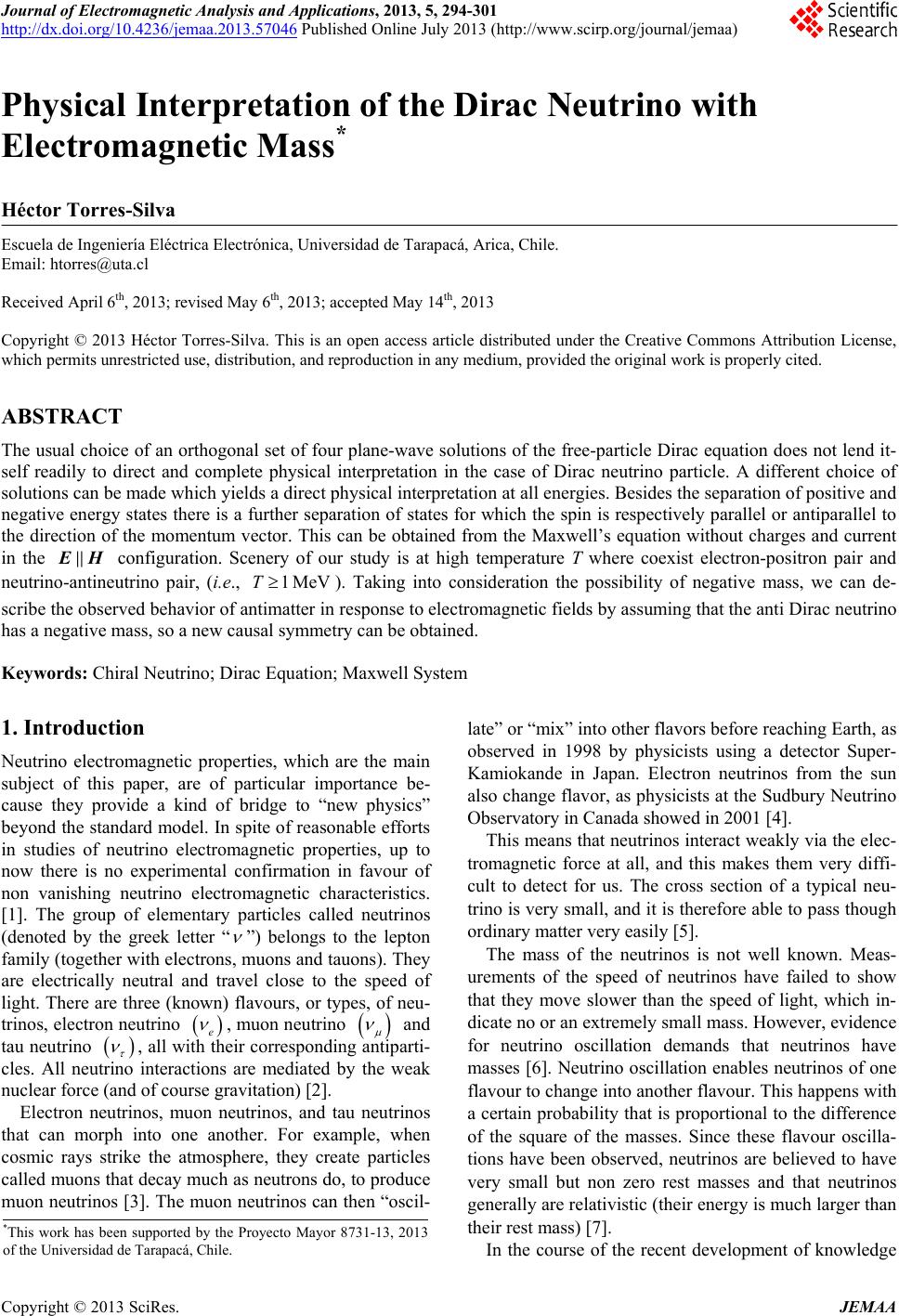 Journal of Electromagnetic Analysis and Applications, 2013, 5, 294-301 http://dx.doi.org/10.4236/jemaa.2013.57046 Published Online July 2013 (http://www.scirp.org/journal/jemaa) Physical Interpretation of the Dirac Neutrino with Electromagnetic Mass* Héctor Torres-Silva Escuela de Ingeniería Eléctrica Electrónica, Universidad de Tarapacá, Arica, Chile. Email: htorres@uta.cl Received April 6th, 2013; revised May 6th, 2013; accepted May 14th, 2013 Copyright © 2013 Héctor Torres-Silva. This is an open access article distributed under the Creative Commons Attribution License, which permits unrestricted use, distribution, and reproduction in any medium, provided the original work is properly cited. ABSTRACT The usual choice of an orthogonal set of four plane-wave solutions of the free-particle Dirac equation does not lend it- self readily to direct and complete physical interpretation in the case of Dirac neutrino particle. A different choice of solutions can be made which yields a direct physical interpretation at all energies. Besides the separation of positive and negative energy states there is a further separation of states for which the spin is respectively parallel or antiparallel to the direction of the momentum vector. This can be obtained from the Maxwell’s equation without charges and current in the H configuration. Scenery of our study is at high temperature T where coexist electron-positron pair and neutrino-antineutrino pair, (i.e., ). Taking into consideration the possibility of negative mass, we can de- scribe the observed behavior of antimatter in response to electromagnetic fields by assuming that the anti Dirac neutrino has a negative mass, so a new causal symmetry can be obtained. 1MeVT Keywords: Chiral Neutrino; Dirac Equation; Maxwell System 1. Introduction Neutrino electromagnetic properties, which are the main subject of this paper, are of particular importance be- cause they provide a kind of bridge to “new physics” beyond the standard model. In spite of reasonable efforts in studies of neutrino electromagnetic properties, up to now there is no experimental confirmation in favour of non vanishing neutrino electromagnetic characteristics. [1]. The group of elementary particles called neutrinos (denoted by the greek letter “ ”) belongs to the lepton family (together with electrons, muons and tauons). They are electrically neutral and travel close to the speed of light. There are three (known) flavours, or types, of neu- trinos, electron neutrino e , muon neutrino and tau neutrino , all with their corresponding antiparti- cles. All neutrino interactions are mediated by the weak nuclear force (and of course gravitation) [2]. Electron neutrinos, muon neutrinos, and tau neutrinos that can morph into one another. For example, when cosmic rays strike the atmosphere, they create particles called muons that decay much as neutrons do, to produce muon neutrinos [3]. The muon neutrinos can then “oscil- late” or “mix” into other flavors before reaching Earth, as observed in 1998 by physicists using a detector Super- Kamiokande in Japan. Electron neutrinos from the sun also change flavor, as physicists at the Sudbury Neutrino Observatory in Canada showed in 2001 [4]. This means that neutrinos interact weakly via the elec- tromagnetic force at all, and this makes them very diffi- cult to detect for us. The cross section of a typical neu- trino is very small, and it is therefore able to pass though ordinary matter very easily [5]. The mass of the neutrinos is not well known. Meas- urements of the speed of neutrinos have failed to show that they move slower than the speed of light, which in- dicate no or an extremely small mass. However, evidence for neutrino oscillation demands that neutrinos have masses [6]. Neutrino oscillation enables neutrinos of one flavour to change into another flavour. This happens with a certain probability that is proportional to the difference of the square of the masses. Since these flavour oscilla- tions have been observed, neutrinos are believed to have very small but non zero rest masses and that neutrinos generally are relativistic (their energy is much larger than their rest mass) [7]. *This work has been supported by the Proyecto Mayor 8731-13, 2013 of the Universidad de Tarapacá, Chile. In the course of the recent development of knowledge Copyright © 2013 SciRes. JEMAA 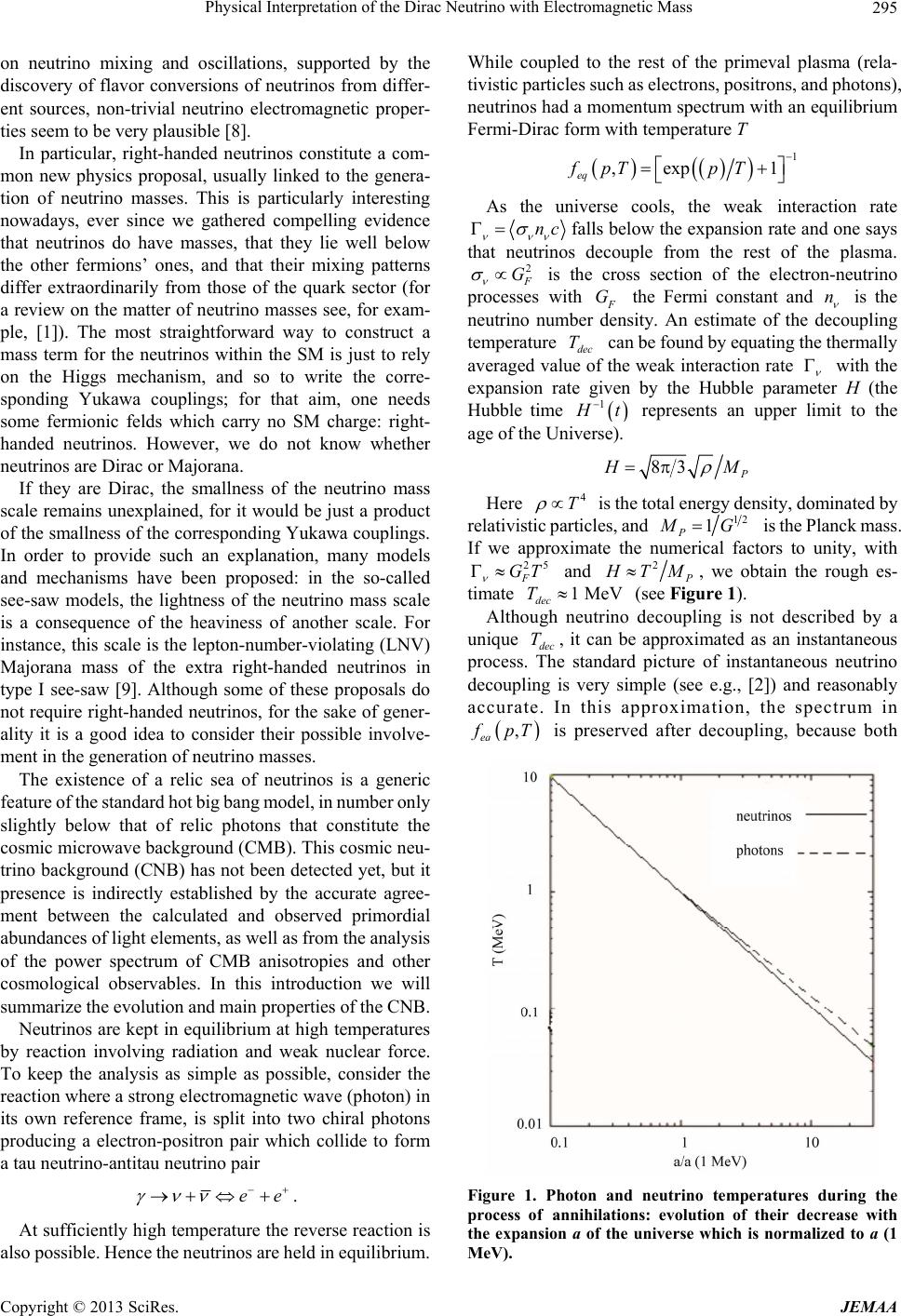 Physical Interpretation of the Dirac Neutrino with Electromagnetic Mass 295 on neutrino mixing and oscillations, supported by the discovery of flavor conversions of neutrinos from differ- ent sources, non-trivial neutrino electromagnetic proper- ties seem to be very plausible [8]. In particular, right-handed neutrinos constitute a com- mon new physics proposal, usually linked to the genera- tion of neutrino masses. This is particularly interesting nowadays, ever since we gathered compelling evidence that neutrinos do have masses, that they lie well below the other fermions’ ones, and that their mixing patterns differ extraordinarily from those of the quark sector (for a review on the matter of neutrino masses see, for exam- ple, [1]). The most straightforward way to construct a mass term for the neutrinos within the SM is just to rely on the Higgs mechanism, and so to write the corre- sponding Yukawa couplings; for that aim, one needs some fermionic felds which carry no SM charge: right- handed neutrinos. However, we do not know whether neutrinos are Dirac or Majorana. If they are Dirac, the smallness of the neutrino mass scale remains unexplained, for it would be just a product of the smallness of the corresponding Yukawa couplings. In order to provide such an explanation, many models and mechanisms have been proposed: in the so-called see-saw models, the lightness of the neutrino mass scale is a consequence of the heaviness of another scale. For instance, this scale is the lepton-number-violating (LNV) Majorana mass of the extra right-handed neutrinos in type I see-saw [9]. Although some of these proposals do not require right-handed neutrinos, for the sake of gener- ality it is a good idea to consider their possible involve- ment in the generation of neutrino masses. The existence of a relic sea of neutrinos is a generic feature of the standard hot big bang model, in number only slightly below that of relic photons that constitute the cosmic microwave background (CMB). This cosmic neu- trino background (CNB) has not been detected yet, but it presence is indirectly established by the accurate agree- ment between the calculated and observed primordial abundances of light elements, as well as from the analysis of the power spectrum of CMB anisotropies and other cosmological observables. In this introduction we will summarize the evolution and main properties of the CNB. Neutrinos are kept in equilibrium at high temperatures by reaction involving radiation and weak nuclear force. To keep the analysis as simple as possible, consider the reaction where a strong electromagnetic wave (photon) in its own reference frame, is split into two chiral photons producing a electron-positron pair which collide to form a tau neutrino-antitau neutrino pair ee . At sufficiently high temperature the reverse reaction is also possible. Hence the neutrinos are held in equilibrium. While coupled to the rest of the primeval plasma (rela- tivistic particles such as electrons, positrons, and photons), neutrinos had a momentum spectrum with an equilibrium Fermi-Dirac form with temperature T 1 ,exp 1 eq fpTpT As the universe cools, the weak interaction rate nc falls below the expansion rate and one says that neutrinos decouple from the rest of the plasma. 2 G is the cross section of the electron-neutrino processes with G the Fermi constant and n is the neutrino number density. An estimate of the decoupling temperature dec can be found by equating the thermally T averaged value of the weak interaction rate with the expansion rate given by the Hubble parameter H (the Hubble time 1 t represents an upper limit to the age of the Universe). 83 M Here is the total energy density, dominated by 4 T relativistic particles, and 12 1 P G is the Planck mass. If we approximate the numerical factors to unity, with 25 GT F and 2 TM, we obtain the rough es- timate 1M dec TeV (see Fi gure 1). Although neutrino decoupling is not described by a unique dec , it can be approximated as an instantaneous T process. The standard picture of instantaneous neutrino decoupling is very simple (see e.g., [2]) and reasonably accurate. In this approximation, the spectrum in , eq pT is preserved after decoupling, because both Figure 1. Photon and neutrino temperatures during the process of annihilations: evolution of their decrease with the expansion a of the universe which is normalized to a (1 MeV). Copyright © 2013 SciRes. JEMAA  Physical Interpretation of the Dirac Neutrino with Electromagnetic Mass 296 neutrino momenta and temperature redshift identically with the expansion of the universe. Shortly after neutrino decoupling the temperature drops below the electron mass, favouring annihilations that heat the photons. If one e assumes that this entropy transfer did not affect the neu- trinos because they were already completely decoupled, it is easy to calculate the change in the photon temperature before any annihilation and after the electron-posi- e tron pairs disappear by assuming entropy conservation of the electromagnetic plasma. Here, we quote the result between T and T [2] 13 after before 11 1.40102 4 TT T T which is also the ratio between the temperatures of relic photons and neutrinos. One can see in Figure 1 how in this epoch the photon temperature decreases with the expansion less than the inverse of the scale factor . Instead the temperature of the decoupled neutrinos always falls as a 1a. Our interest is to study the electromagnetic process for the conversion ee at . This paper is structured as follows. In Section 2 we start by reviewing the Dirac equation under chiral representation. In Section 3 we obtain the Dirac equation deduced from Maxwell’s equations with 1MeVT H applied to neutrino at which can provide light neutrino masses under a chiral electromagnetic mechanism. Section 4 discusses the chi- ral electromagnetic neutrino. 1MeVT 2. Chiral Dirac Neutrino Equation Plane-wave solutions of the Dirac equation are well known, and it would appear to be necessary to justify a reconsideration of this problem related with Dirac neu- trino particles. The justification lies in the fact that the solutions found in journals and elsewhere do not lend themselves readily to a direct physical interpretation. In the usual treatment of the problem, four mutually or- thogonal solutions are obtained for a given value of the momentum p, two of which correspond to positive en- ergy and two to negative energy. However, the physical distinction between a pair of solutions belonging to the same energy does not appear until one considers the low energy approximation in which the small components of the state function are neglected and the two solutions reduce to eigenfunctions of belonging to eigenval- ues . 1 The original Dirac equation is 2 ˆˆ cpmci t (1a) where ψ = ψ(r, t) is a complex four-component field ψ that Dirac thought of as the wave function for the electron, r and t are the space and time coordinates, m is the rest mass of the electron, is the momentum operator, c is the speed of light speed, and is the reduced Planck constant Planck (h/2π). Furthermore, ˆ p ˆ is a vector operator whose components are 4 × 4 matrices: 123 ˆ,, , and is another 4 × 4 matrix. In the usual notation, the Dirac Hamiltonian for a free particle is [10] 2 ˆˆ cpmc . (1b) This Hamiltonian commutes with the momentum vec- tor , and the usual procedure is to seek simultaneous eigenfunctions of H and p. These eigenfunctions are, however, not uniquely determined, and for given eigen- values of H and p, there remains a twofold degeneracy. In order to resolve this degeneracy we seek a dynamical variable which commutes with both H and . Such a variable is ˆ p ˆ p ˆˆ p , where ˆ is the matrix Pauli. It is ob- vious that this variable commutes with . To verify that it also commutes with H, we write 11 ˆ p ˆˆˆ , and recalling that commutes with operator ˆ , we have 11 ˆˆ ˆˆˆˆˆˆ0 cpp pcp , (2) since 1 commutes with ˆ . We now proceed to find simultaneous eigenfunctions of the commuting variables H, p and ˆˆ p . We have, since the components of p commute, 22 ˆˆ pp , (3) where p is the magnitude of the momentum vector. Thus for a simultaneous eigenstate of and ˆ pˆˆ p , the value of ˆˆ p will be +p or –p, corresponding to states for which the spin is parallel or antiparallel, respectively, to the momentum vector. A simultaneous eigenfunction of H and p will have the form of a plane wave [10] ,exp, 1,2,3,4 jj rtip rWtj , (4) where are the four components of the wave function and are four numbers to be determined. In the ar- gument of the exponential function, p represents the ei- genvalues of the components of the momentum for this state and W the corresponding eigenvalue of H. The possibility of positive mass and negative mass is for- mally consistent with the positive and negative solutions to the equations of the Special Theory of Relativity when combined with quantum mechanics [11]. Then can have either of the two values. W 1 2 242 2 Wmccp . (5) In Equation (5) is the relativistic momentum and is the invariant mass. There are two solutions to Equation (5); a positive solution and a negative solution. p m Copyright © 2013 SciRes. JEMAA 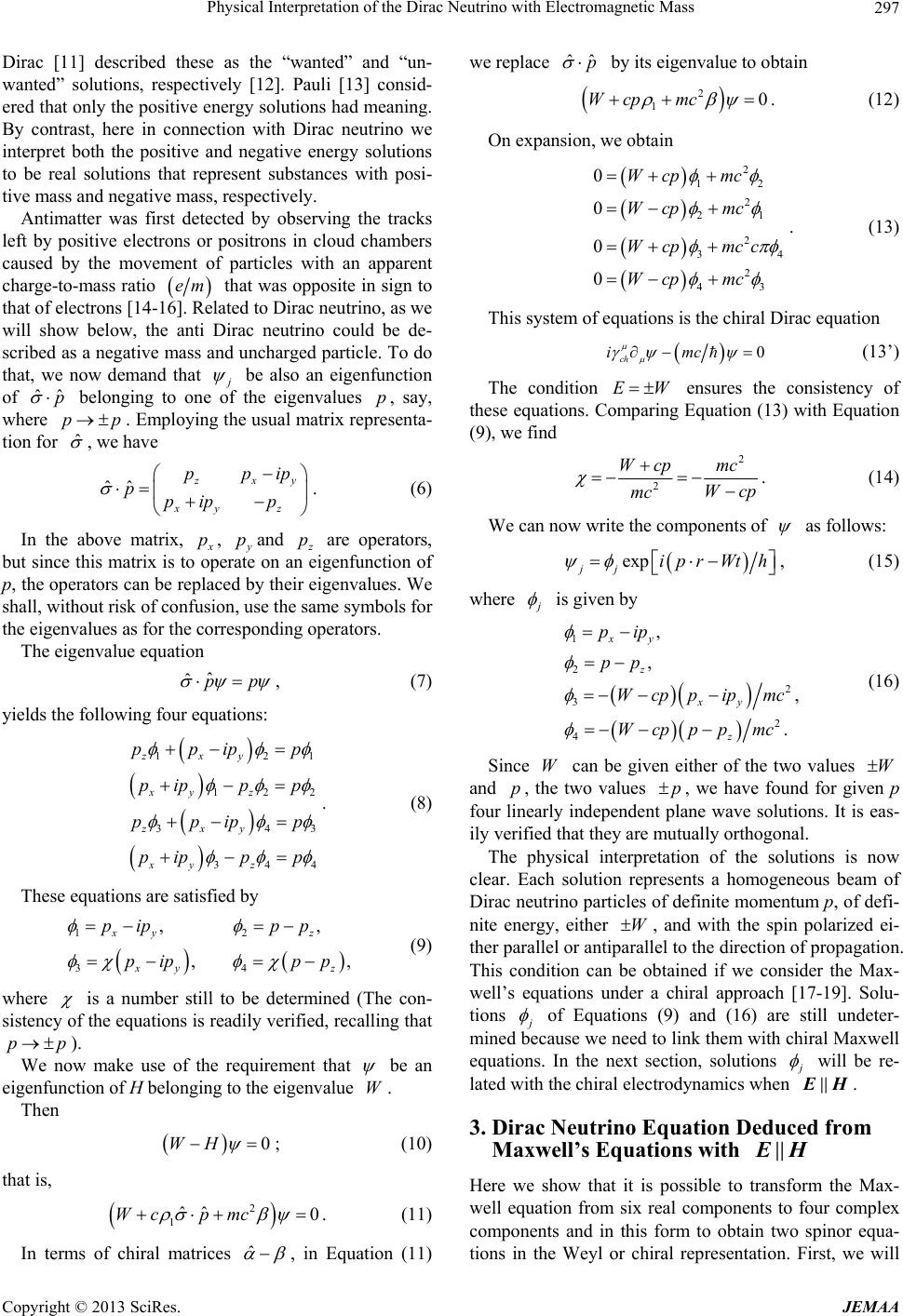 Physical Interpretation of the Dirac Neutrino with Electromagnetic Mass 297 Dirac [11] described these as the “wanted” and “un- wanted” solutions, respectively [12]. Pauli [13] consid- ered that only the positive energy solutions had meaning. By contrast, here in connection with Dirac neutrino we interpret both the positive and negative energy solutions to be real solutions that represent substances with posi- tive mass and negative mass, respectively. Antimatter was first detected by observing the tracks left by positive electrons or positrons in cloud chambers caused by the movement of particles with an apparent charge-to-mass ratio em that was opposite in sign to that of electrons [14-16]. Related to Dirac neutrino, as we will show below, the anti Dirac neutrino could be de- scribed as a negative mass and uncharged particle. To do that, we now demand that be also an eigenfunction of ˆˆ p belonging to one of the eigenvalues , say, where . Employing the usual matrix representa- tion for p p ˆ p , we have ˆˆ xy xy z ppip ppip p . (6) In the above matrix, p, pand p are operators, but since this matrix is to operate on an eigenfunction of p, the operators can be replaced by their eigenvalues. We shall, without risk of confusion, use the same symbols for the eigenvalues as for the corresponding operators. The eigenvalue equation ˆˆ pp , (7) yields the following four equations: 12 12 34 34 zxy xy z zxy xy z ppip p pipp p ppip p pipp p 1 2 3 4 . (8) These equations are satisfied by 12 34 , , xy z xy z pippp pip pp , , (9) where is a number still to be determined (The con- sistency of the equations is readily verified, recalling that ). pp We now make use of the requirement that be an eigenfunction of H belonging to the eigenvalue . Then W 0WH ; (10) that is, 2 1ˆˆ 0Wc pmc . (11) In terms of chiral matrices ˆ , in Equation (11) we replace ˆˆ p by its eigenvalue to obtain 2 10Wcpmc . (12) On expansion, we obtain 2 12 2 21 2 34 2 43 Wc p mc Wcpmc Wcp mcc Wcpmc 0 0 0 0 . (13) This system of equations is the chiral Dirac equation 0 ch imc (13’) The condition EW ensures the consistency of these equations. Comparing Equation (13) with Equation (9), we find 2 2 Wcpmc Wcp mc . (14) We can now write the components of as follows: exp jj iprWth , (15) where is given by 1 2 3 4 2 2 , , , . xy z xy z pip pp Wcppipmc Wcppp mc (16) Since can be given either of the two values W W and , the two values p p , we have found for given p four linearly independent plane wave solutions. It is eas- ily verified that they are mutually orthogonal. The physical interpretation of the solutions is now clear. Each solution represents a homogeneous beam of Dirac neutrino particles of definite momentum p, of defi- nite energy, either W , and with the spin polarized ei- ther parallel or antiparallel to the direction of propagation. This condition can be obtained if we consider the Max- well’s equations under a chiral approach [17-19]. Solu- tions of Equations (9) and (16) are still undeter- mined because we need to link them with chiral Maxwell equations. In the next section, solutions will be re- lated with the chiral electrodynamics when H. 3. Dirac Neutrino Equation Deduced from Maxwell’s Equations with H Here we show that it is possible to transform the Max- well equation from six real components to four complex components and in this form to obtain two spinor equa- tions in the Weyl or chiral representation. First, we will Copyright © 2013 SciRes. JEMAA 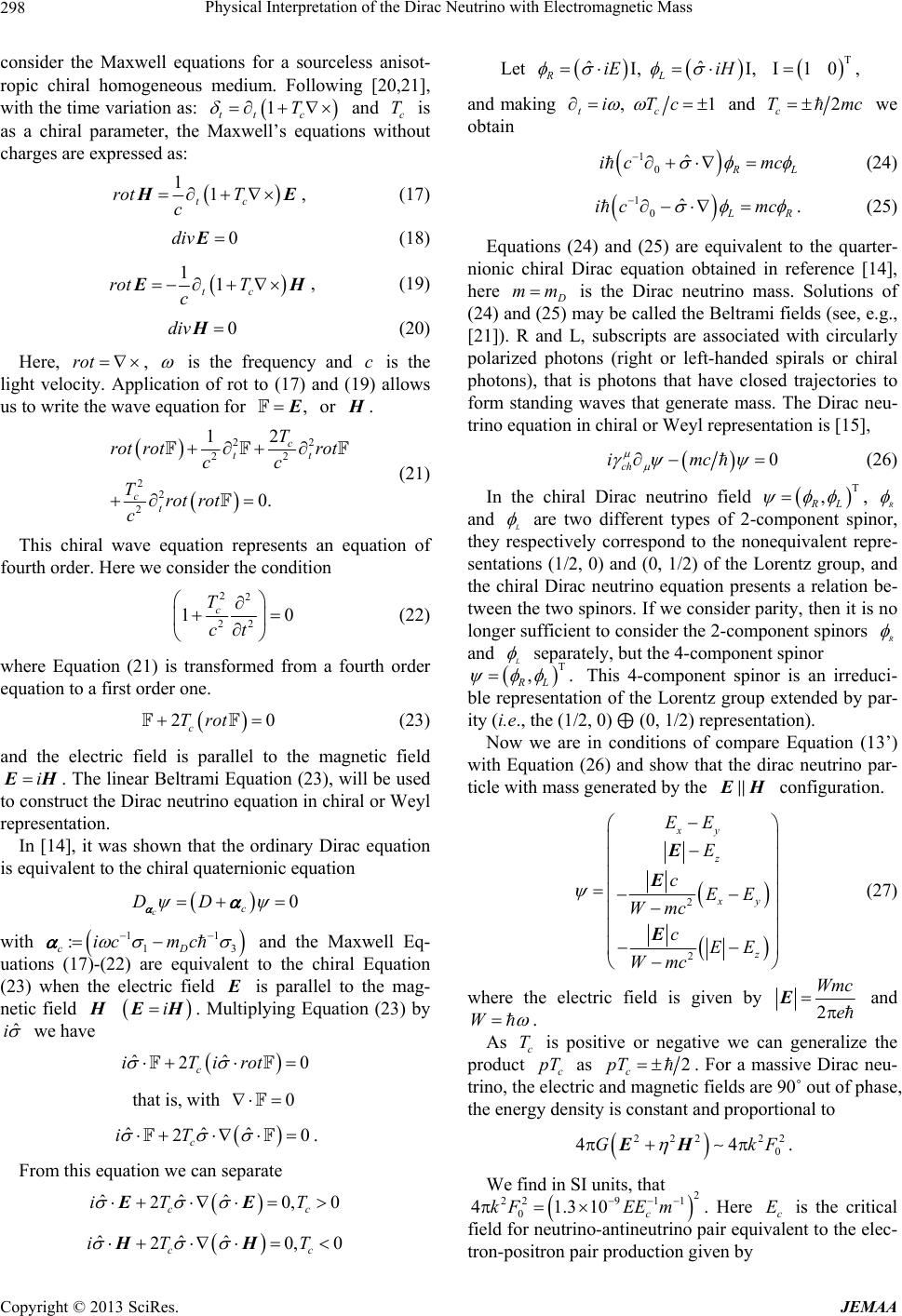 Physical Interpretation of the Dirac Neutrino with Electromagnetic Mass 298 consider the Maxwell equations for a sourceless anisot- ropic chiral homogeneous medium. Following [20,21], with the time variation as: 1 tt c T and c T is as a chiral parameter, the Maxwell’s equations without charges are expressed as: 11 tc rot T c E, (17) 0div E (18) 11 tc rot T c H, (19) 0div H (20) Here, , rot is the frequency and is the light velocity. Application of rot to (17) and (19) allows us to write the wave equation for c , or . 22 22 2 2 2 2 1 0. c tt c t T rot rotrot cc Trotrot c (21) This chiral wave equation represents an equation of fourth order. Here we consider the condition 22 22 1 c T ct 0 0 (22) where Equation (21) is transformed from a fourth order equation to a first order one. 2 c Trot (23) and the electric field is parallel to the magnetic field i H. The linear Beltrami Equation (23), will be used to construct the Dirac neutrino equation in chiral or Weyl representation. In [14], it was shown that the ordinary Dirac equation is equivalent to the chiral quaternionic equation 0 cc DD with 3 1 1 : cD ic mc 1 and the Maxwell Eq- uations (17)-(22) are equivalent to the chiral Equation (23) when the electric field is parallel to the mag- netic field i H. Multiplying Equation (23) by ˆ i we have ˆˆ 20 c iTirot that is, with 0 ˆˆ ˆ 20 c iT . From this equation we can separate ˆˆˆ 20 cc iT T EE ,0 ,0 ˆˆ ˆ 20 cc iT T HH Let ˆˆ , RL iE iH , T 10 , and making ,1 tc iTc and 2 c Tmc we obtain 1 0ˆ L ic mc (24) 1 0ˆ R ic mc . (25) Equations (24) and (25) are equivalent to the quarter- nionic chiral Dirac equation obtained in reference [14], here mm is the Dirac neutrino mass. Solutions of (24) and (25) may be called the Beltrami fields (see, e.g., [21]). R and L, subscripts are associated with circularly polarized photons (right or left-handed spirals or chiral photons), that is photons that have closed trajectories to form standing waves that generate mass. The Dirac neu- trino equation in chiral or Weyl representation is [15], 0 ch imc (26) In the chiral Dirac neutrino field T , RL , and are two different types of 2-component spinor, they respectively correspond to the nonequivalent repre- sentations (1/2, 0) and (0, 1/2) of the Lorentz group, and the chiral Dirac neutrino equation presents a relation be- tween the two spinors. If we consider parity, then it is no longer sufficient to consider the 2-component spinors and separately, but the 4-component spinor This 4-component spinor is an irreduci- ble representation of the Lorentz group extended by par- ity (i.e., the (1/2, 0) ⊕ (0, 1/2) representation). T , RL . Now we are in conditions of compare Equation (13’) with Equation (26) and show that the dirac neutrino par- ticle with mass generated by the H configuration. 2 2 xy z xy z EE E cEE Wmc cEE Wmc E E E (27) where the electric field is given by 2 Wmc e E and W T . As c is positive or negative we can generalize the product c as pT 2 c pT . For a massive Dirac neu- trino, the electric and magnetic fields are 90˚ out of phase, the energy density is constant and proportional to 222 2 0 44Gk EH2 F . We find in SI units, that . Here c is the critical field for neutrino-antineutrino pair equivalent to the elec- tron-positron pair production given by 2 2291 1 0 41.310 c kFEEm E Copyright © 2013 SciRes. JEMAA  Physical Interpretation of the Dirac Neutrino with Electromagnetic Mass 299 23 11181 1.3 10 Vm ce Emce . (28) That is equivalent to . Observations indi- cate that neutron stars have magnetic fields higher than so neutrino-antineutrino pair is generated. In this form we have a close connection between the Dirac neu- trino equation and the Maxwell’s equation, with a direct and complete physical interpretation in the 12 1.310G 12 10 G H T con- figuration. Here we are obtained a clear connection be- tween the Planck constant , the quiral factor c, and the electromagnetic mass which can be positive or nega- tive according to . c It is well known that matter and antimatter respond to electromagnetic radiation in opposite ways. For example, if an electron (Dirac neutrino) moves one way in an elec- tromagnetic field, a positron (Dirac anti neutrino) will move in the opposite way. We apply our theory of posi- tive and negative mass to matter and antimatter and sug- gest that it is productive to consider matter as having a positive mass (+chirality) and antimatter as having a negative mass (−chirality). The equations presented here, which treat matter as having a positive mass and anti- matter as having a negative mass, can account for the experimental observations of matter and antimatter in chiral electromagnetic fields. Our treatment allows the symmetry between matter and antimatter to be treated in a more causal manner. T Taking into consideration the possibility of negative mass, we can describe the observed behavior of antimat- ter in response to electromagnetic fields by assuming that the positron (anti Dirac neutrino) has a negative mass. Given that particles and antiparticles respond oppositely to an input of various forms of electromagnetic energy, we considered the possibility that the mass can be con- sidered in a causal symmetry. Taking into account the concept of relative time, particularly the relativity of the direction of time to describe antimatter, we now suggest a more causal symmetry between matter and antimatter. That is, instead of using CPT symmetry [22], where matter is antisymmetrical with antimatter in terms of its charge (C), parity (P) and direction in time (T), we sug- gest that matter is antisymmetrical with antimatter in terms of its mass, parity and time. part conjantipart PT MPT . (29) So the combined MPT operations leaves invariant the Dirac Equation (1) 2 2 : ˆˆ ˆˆ particle MPT cpmci t cpmc it (30) In the chiral representation also can be show that the Dirac neutrino equation is invariant. 4. Chiral Electromagnetic Neutrino Dirac introduced the concept of antiparticles, [23]. Now we know that for every particle there is an antiparticle. However some particles could be self-conjugate, in the sense that particle and antiparticle could be the same. Of course such particles have to be electrically neutral. The possibility of a self-conjugate fermion was first pointed out by Majorana [24], and hence they are called Majorana fermions while the other fermions (with dis- tinct particles and antiparticles) are called Dirac fermions, Equations (24) and (25) [25]. Among the fermions of the Standard Model, only neutrinos are electrically neutral and hence qualify to be Majorana particles. But it is still an open question whether neutrinos are Majorana parti- cles or Dirac particles. In our theory we can discriminate this situation if 1 2 c Tmc with , RL mm or 3 2 c Tmc with mm respectively. If neutrinos are Majorana particles, lepton number L is not conserved and this opens the door to generate an ex- cess of leptons over antileptons in the early universe which can subsequently generate an excess of baryons over antibaryons, thus explaining how after annihilation of most of the particles with antiparticles, a finite but small residue of particles was left, to make up the present Universe. Equations (24) and (25) support the see-saw mecha- nism to explain why the neutrino masses, although not zero, are so tiny.The seesaw mechanism is a generic model used to understand the relative sizes of observed neutrino masses, of the order of eV. See‐saw mechanism maybe the reason for the smallness of the masses. *Provides an explanation for the smallness of the neu- trino masses; *0 L m is natural, since a mass term is forbid- den by the SM symmetries; * m, generated by the Higgs mechanism can be taken the order of the charged lepton masses; * m is not “protected” by the SM symmetries, and can be taken large. With our theory, using Equations (24) and (25) it is possible to obtain a matrix mass LD R mm mm . (31) If with 1eVm D we obtain two Majo- rana particles, an electron neutrino light and a sterile heavy one mm 1eV 1TeV R. In addition to the non- zero neutrino masses and mixing angles, the nonzero magnetic moment m is another property of neutrinos beyond the standard model of particle physics. The im- Copyright © 2013 SciRes. JEMAA 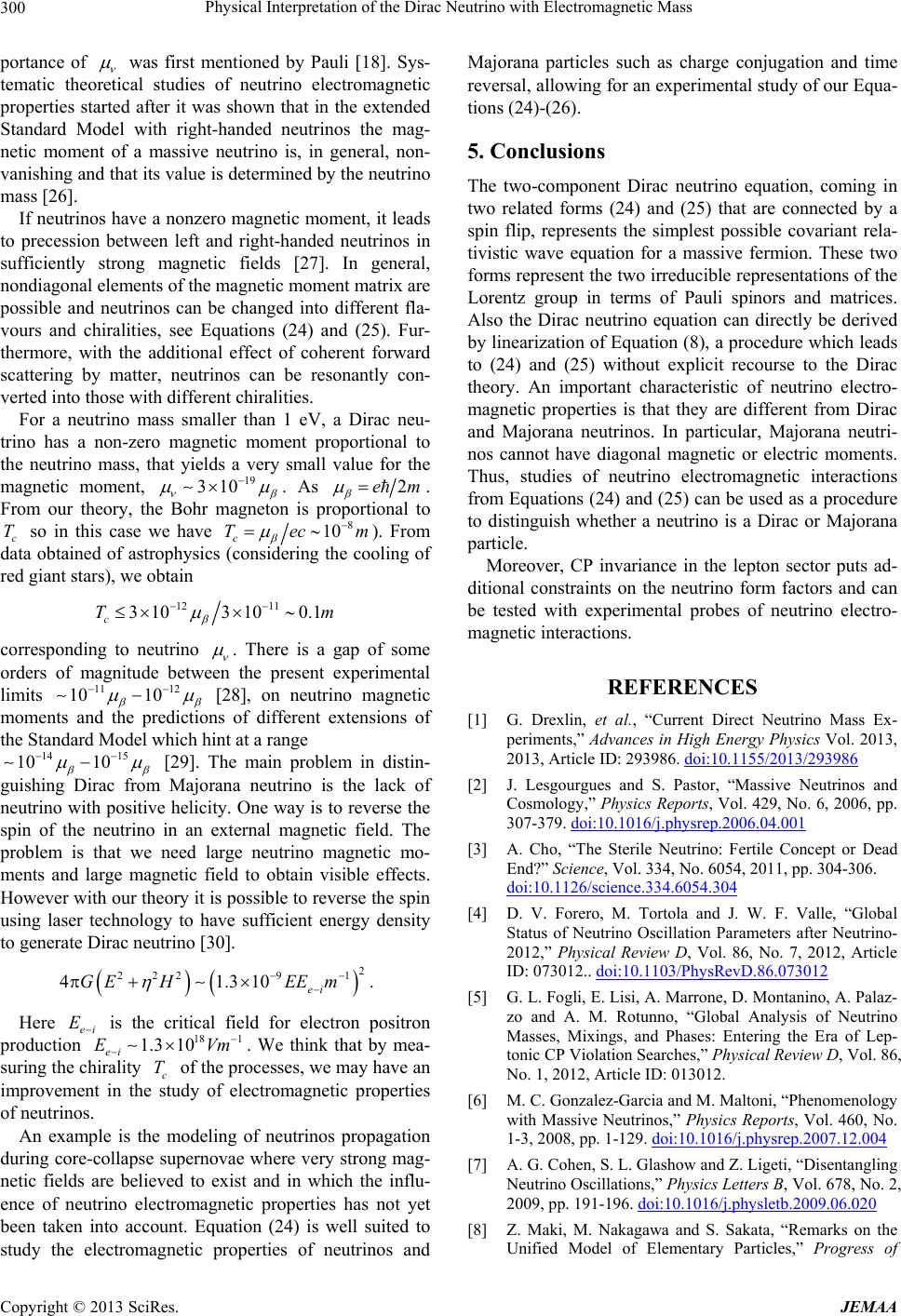 Physical Interpretation of the Dirac Neutrino with Electromagnetic Mass 300 portance of was first mentioned by Pauli [18]. Sys- tematic theoretical studies of neutrino electromagnetic properties started after it was shown that in the extended Standard Model with right-handed neutrinos the mag- netic moment of a massive neutrino is, in general, non- vanishing and that its value is determined by the neutrino mass [26]. If neutrinos have a nonzero magnetic moment, it leads to precession between left and right-handed neutrinos in sufficiently strong magnetic fields [27]. In general, nondiagonal elements of the magnetic moment matrix are possible and neutrinos can be changed into different fla- vours and chiralities, see Equations (24) and (25). Fur- thermore, with the additional effect of coherent forward scattering by matter, neutrinos can be resonantly con- verted into those with different chiralities. For a neutrino mass smaller than 1 eV, a Dirac neu- trino has a non-zero magnetic moment proportional to the neutrino mass, that yields a very small value for the magnetic moment, 19 310 . As 2em . From our theory, the Bohr magneton is proportional to c so in this case we have T8 10 c Tecm ). From data obtained of astrophysics (considering the cooling of red giant stars), we obtain 12 11 3 103 100.1 c Tm corresponding to neutrino . There is a gap of some orders of magnitude between the present experimental limits 11 12 10 10 15 10 [28], on neutrino magnetic moments and the predictions of different extensions of the Standard Model which hint at a range 14 10 [29]. The main problem in distin- guishing Dirac from Majorana neutrino is the lack of neutrino with positive helicity. One way is to reverse the spin of the neutrino in an external magnetic field. The problem is that we need large neutrino magnetic mo- ments and large magnetic field to obtain visible effects. However with our theory it is possible to reverse the spin using laser technology to have sufficient energy density to generate Dirac neutrino [30]. 2 22291 41.310 ei HEE m GE ei . Here ei is the critical field for electron positron production E18 1 1.3 10EVm T . We think that by mea- suring the chirality c of the processes, we may have an improvement in the study of electromagnetic properties of neutrinos. An example is the modeling of neutrinos propagation during core-collapse supernovae where very strong mag- netic fields are believed to exist and in which the influ- ence of neutrino electromagnetic properties has not yet been taken into account. Equation (24) is well suited to study the electromagnetic properties of neutrinos and Majorana particles such as charge conjugation and time reversal, allowing for an experimental study of our Equa- tions (24)-(26). 5. Conclusions The two-component Dirac neutrino equation, coming in two related forms (24) and (25) that are connected by a spin flip, represents the simplest possible covariant rela- tivistic wave equation for a massive fermion. These two forms represent the two irreducible representations of the Lorentz group in terms of Pauli spinors and matrices. Also the Dirac neutrino equation can directly be derived by linearization of Equation (8), a procedure which leads to (24) and (25) without explicit recourse to the Dirac theory. An important characteristic of neutrino electro- magnetic properties is that they are different from Dirac and Majorana neutrinos. In particular, Majorana neutri- nos cannot have diagonal magnetic or electric moments. Thus, studies of neutrino electromagnetic interactions from Equations (24) and (25) can be used as a procedure to distinguish whether a neutrino is a Dirac or Majorana particle. Moreover, CP invariance in the lepton sector puts ad- ditional constraints on the neutrino form factors and can be tested with experimental probes of neutrino electro- magnetic interactions. REFERENCES [1] G. Drexlin, et al., “Current Direct Neutrino Mass Ex- periments,” Advances in High Energy Physics Vol. 2013, 2013, Article ID: 293986. doi:10.1155/2013/293986 [2] J. Lesgourgues and S. Pastor, “Massive Neutrinos and Cosmology,” Physics Reports, Vol. 429, No. 6, 2006, pp. 307-379. doi:10.1016/j.physrep.2006.04.001 [3] A. Cho, “The Sterile Neutrino: Fertile Concept or Dead End?” Science, Vol. 334, No. 6054, 2011, pp. 304-306. doi:10.1126/science.334.6054.304 [4] D. V. Forero, M. Tortola and J. W. F. Valle, “Global Status of Neutrino Oscillation Parameters after Neutrino- 2012,” Physical Review D, Vol. 86, No. 7, 2012, Article ID: 073012.. doi:10.1103/PhysRevD.86.073012 [5] G. L. Fogli, E. Lisi, A. Marrone, D. Montanino, A. Palaz- zo and A. M. Rotunno, “Global Analysis of Neutrino Masses, Mixings, and Phases: Entering the Era of Lep- tonic CP Violation Searches,” Physical Review D, Vol. 86, No. 1, 2012, Article ID: 013012. [6] M. C. Gonzalez-Garcia and M. Maltoni, “Phenomenology with Massive Neutrinos,” Physics Reports, Vol. 460, No. 1-3, 2008, pp. 1-129. doi:10.1016/j.physrep.2007.12.004 [7] A. G. Cohen, S. L. Glashow and Z. Ligeti, “Disentangling Neutrino Oscillations,” Physics Letters B, Vol. 678, No. 2, 2009, pp. 191-196. doi:10.1016/j.physletb.2009.06.020 [8] Z. Maki, M. Nakagawa and S. Sakata, “Remarks on the Unified Model of Elementary Particles,” Progress of Copyright © 2013 SciRes. JEMAA 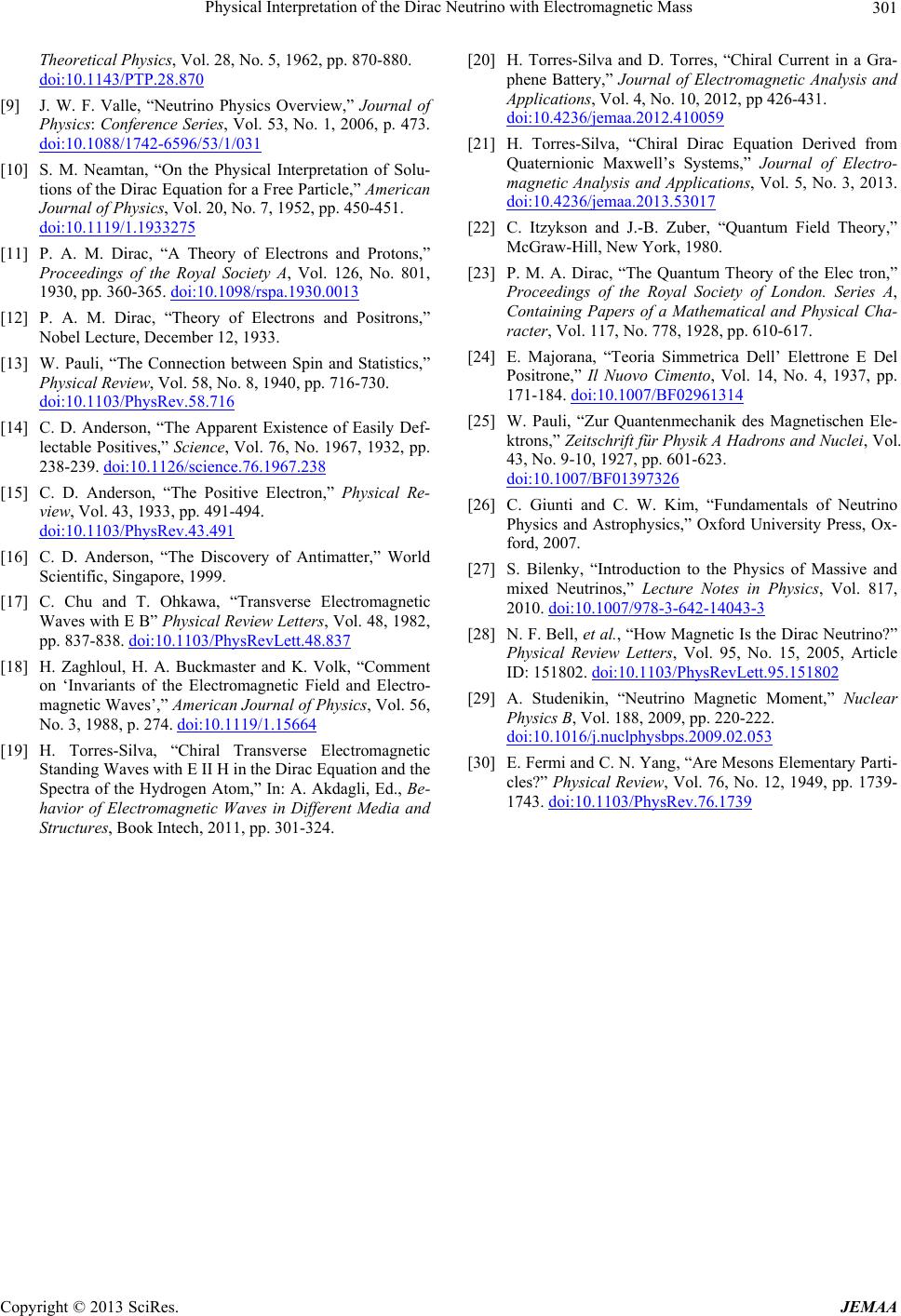 Physical Interpretation of the Dirac Neutrino with Electromagnetic Mass Copyright © 2013 SciRes. JEMAA 301 Theoretical Physics, Vol. 28, No. 5, 1962, pp. 870-880. doi:10.1143/PTP.28.870 [9] J. W. F. Valle, “Neutrino Physics Overview,” Journal of Physics: Conference Series, Vol. 53, No. 1, 2006, p. 473. doi:10.1088/1742-6596/53/1/031 [10] S. M. Neamtan, “On the Physical Interpretation of Solu- tions of the Dirac Equation for a Free Particle,” American Journal of Physics, Vol. 20, No. 7, 1952, pp. 450-451. doi:10.1119/1.1933275 [11] P. A. M. Dirac, “A Theory of Electrons and Protons,” Proceedings of the Royal Society A, Vol. 126, No. 801, 1930, pp. 360-365. doi:10.1098/rspa.1930.0013 [12] P. A. M. Dirac, “Theory of Electrons and Positrons,” Nobel Lecture, December 12, 1933. [13] W. Pauli, “The Connection between Spin and Statistics,” Physical Review, Vol. 58, No. 8, 1940, pp. 716-730. doi:10.1103/PhysRev.58.716 [14] C. D. Anderson, “The Apparent Existence of Easily Def- lectable Positives,” Science, Vol. 76, No. 1967, 1932, pp. 238-239. doi:10.1126/science.76.1967.238 [15] C. D. Anderson, “The Positive Electron,” Physical Re- view, Vol. 43, 1933, pp. 491-494. doi:10.1103/PhysRev.43.491 [16] C. D. Anderson, “The Discovery of Antimatter,” World Scientific, Singapore, 1999. [17] C. Chu and T. Ohkawa, “Transverse Electromagnetic Waves with E B” Physical Review Letters, Vol. 48, 1982, pp. 837-838. doi:10.1103/PhysRevLett.48.837 [18] H. Zaghloul, H. A. Buckmaster and K. Volk, “Comment on ‘Invariants of the Electromagnetic Field and Electro- magnetic Waves’,” American Journal of Physics, Vol. 56, No. 3, 1988, p. 274. doi:10.1119/1.15664 [19] H. Torres-Silva, “Chiral Transverse Electromagnetic Standing Waves with E II H in the Dirac Equation and the Spectra of the Hydrogen Atom,” In: A. Akdagli, Ed., Be- havior of Electromagnetic Waves in Different Media and Structures, Book Intech, 2011, pp. 301-324. [20] H. Torres-Silva and D. Torres, “Chiral Current in a Gra- phene Battery,” Journal of Electromagnetic Analysis and Applications, Vol. 4, No. 10, 2012, pp 426-431. doi:10.4236/jemaa.2012.410059 [21] H. Torres-Silva, “Chiral Dirac Equation Derived from Quaternionic Maxwell’s Systems,” Journal of Electro- magnetic Analysis and Applications, Vol. 5, No. 3, 2013. doi:10.4236/jemaa.2013.53017 [22] C. Itzykson and J.-B. Zuber, “Quantum Field Theory,” McGraw-Hill, New York, 1980. [23] P. M. A. Dirac, “The Quantum Theory of the Elec tron,” Proceedings of the Royal Society of London. Series A, Containing Papers of a Mathematical and Physical Cha- racter, Vol. 117, No. 778, 1928, pp. 610-617. [24] E. Majorana, “Teoria Simmetrica Dell’ Elettrone E Del Positrone,” Il Nuovo Cimento, Vol. 14, No. 4, 1937, pp. 171-184. doi:10.1007/BF02961314 [25] W. Pauli, “Zur Quantenmechanik des Magnetischen Ele- ktrons,” Zeitschrift für Physik A Hadrons and Nuclei, Vol. 43, No. 9-10, 1927, pp. 601-623. doi:10.1007/BF01397326 [26] C. Giunti and C. W. Kim, “Fundamentals of Neutrino Physics and Astrophysics,” Oxford University Press, Ox- ford, 2007. [27] S. Bilenky, “Introduction to the Physics of Massive and mixed Neutrinos,” Lecture Notes in Physics, Vol. 817, 2010. doi:10.1007/978-3-642-14043-3 [28] N. F. Bell, et al., “How Magnetic Is the Dirac Neutrino?” Physical Review Letters, Vol. 95, No. 15, 2005, Article ID: 151802. doi:10.1103/PhysRevLett.95.151802 [29] A. Studenikin, “Neutrino Magnetic Moment,” Nuclear Physics B, Vol. 188, 2009, pp. 220-222. doi:10.1016/j.nuclphysbps.2009.02.053 [30] E. Fermi and C. N. Yang, “Are Mesons Elementary Parti- cles?” Physical Review, Vol. 76, No. 12, 1949, pp. 1739- 1743. doi:10.1103/PhysRev.76.1739
|